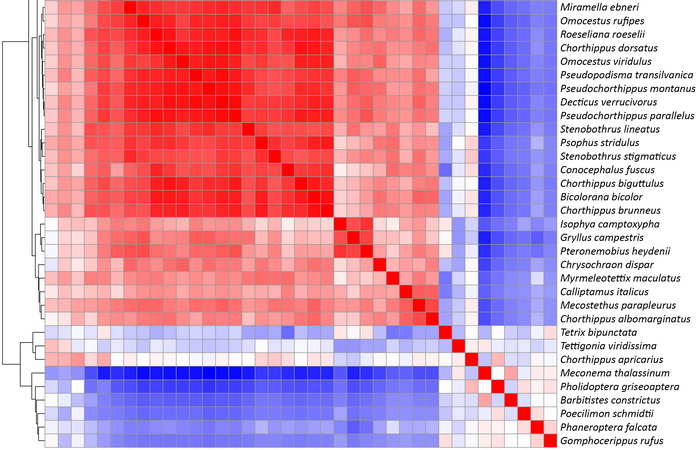Care este habitatul de prim interes în conservarea speciilor de ortoptere (Insecta: Orthoptera) într-o zonă protejată din Carpații Orientali ? - Rezultate preliminare
DOI:
https://doi.org/10.4316/bf.2025.003Cuvinte cheie:
ortoptere, specii indicatoare, pajiște, ecoton, pădure, Pholidoptera transsylvanicaRezumat
Studiul s-a desfășurat în zona protejată Fânețele Todirescu din masivul Rarău în perioada mai-septembrie 2024, și au fost investigate trei tipuri de habitatele preferate de ortoptere. Dintre acestea, pajiștea a fost identificată ca fiind habitatul cel mai bogat în biodiversitate, găzduind o varietate mare de specii de ortoptere, cum ar fi indicatorul Pseudochorthippus montanus. Ecotonul pajiște – pădure a prezentat o diversitate intermediară, cu specii de tranziție, în timp ce pădurea a înregistrat cea mai scăzută diversitate a speciilor de ortoptere. Pholidoptera transsylvanica, singura specie de interes comunitar din zona de studiu, este un specialist pentru pajiști montane, dar a fost întâlnită și în liziera pădurii.
Descărcări
Vizualizări
Referințe
Arnóczkyné Jakab D. Nagy A., 2022. How can an intensively used agricultural landscape preserve diversity of Orthoptera assemblages? Journal of Insect Conservation 26(6): 947-958. doi: 10.1007/s10841-022-00439-7
Barbu C.-O., Duduman G., Tomescu C.V., 2023. Variation Patterns of Forest Structure Diversity after Set-Aside in Rarău-Giumalău Mountains, Romania. Forests 14(2): 251. https://doi.org/10.3390/f14020251
Cigliano M.M., Braun H., Eades D.C., Otte D., 2025. Orthoptera Species File. Accesat la 29.05.2025. http://orthoptera.speciesfile.org/
Dabrowska-Prot E., Wasilowska A., 2010. Ecological importance of meadow patches in protected forest area: floristic diversity and the dynamics of insect communities. Polish Journal of Ecology 58(4): 741-758.
Dítě D., Hájková P., Goia I., Hájek M., 2015. Carex vaginata — new relict species in the Romanian flora. Contribuţii Botanice, Cluj-Napoca: Grădina Botanică “Alexandru Borza” 50: 7-13.
Duduman G., Duduman M.-L., Avăcăriței D., Barnoaiea I., Barbu C.-O., Ciornei I., Clinovschi F., Coșofreț V.C., Cotos M.-G., Dănilă G., Dănilă I.-C. Drăgoi M., Flocea M.-N., Horodnic S.-A., Iacobescu O., Mazăre G. C., Măciucă A., Mursa A., Palaghianu C., Roibu C.-C., Pohonțu C.M., Savin A., Tomescu C.V., Scriban R.-E., 2020. A Permanent Research Platform for Ecological Studies in Intact Temperate Mountainous Forests from Slătioara UNESCO Site and Its Surroundings, Romania. Forests 11(9): 1004. https://doi.org/10.3390/f11091004
Essl F., Dirnböck T., 2012. What determines Orthoptera species distribution and richness in temperate semi-natural dry grassland remnants? Biodiversity and Conservation 21(10): 2525-2537. https://doi.org/10.1007/S10531-012-0315-1
Fabriciusová V., Kaňuch P., Krištín A., 2011. Response of Orthoptera assemblages to management of montane grasslands in the Western Carpathians. Biologia 66(6): 1127-1133. doi: 10.2478/S11756-011-0115-1
Iorgu I.Ş., Iorgu E.I., 2008. Bush-crickets, crickets and grasshoppers from Moldavia (Romania). Editura Pim, Iaşi, 294 pp.
Jordán F., Báldi A., Orci KM., Rácz I., Varga Z., 2003. Characterizing the importance of habitat patches and corridors in maintaining the landscape connectivity of a Pholidoptera transsylvanica (Orthoptera) metapopulation. Landscape Ecology 18: 83-92. https://doi.org/10.1023/A:1022958003528
Kenyeres Z., Takács G., Bauer N., 2019. Response of orthopterans to macroclimate changes: A 15-year case study in Central European humid grasslands. Journal of Orthoptera Research 28(2): 187-193. https://doi.org/10.3897/JOR.28.34102
Klimm F.S., Bräu M., König S., Mandery K., Sommer C., Zhang J., Krauss J., 2024. Importance of habitat area, quality and landscape context for heteropteran diversity in shrub ecotones. Landscape Ecology 39: 3. https://doi.org/10.1007/s10980-024-01798-z
Krištín A., Iorgu I.Ş., 2014. Red List of Grasshoppers, Bush-crickets and Crickets (Orthoptera) of the Carpathian Mountains. În: Kadlečík J. (Ed.) Carpathian Red List of Forest Habitats and Species. Carpathian List of Invasive Alien Species. Štátna ochrana prírody Slovenskej republiky, 234 pp.
Orczewska A., Glista A., 2005. Floristic analysis of the two woodland-meadow ecotones differing in orientation of the forest edge. Polish Journal of Ecology 53(3): 365-382.
Pernat N., Buchholz S., Schirmel J., 2024. Urbanization reduces Orthoptera diversity and changes community structure towards mobile species. Insect Conservation and Diversity 17(2): 259-272. https://doi.org/10.1111/icad.12727
Poniatowski D., Weißgräber V., Drung M., Freienstein F.M., Kettermann M., Scherer G., Fartmann T., 2024. Grassland nature reserves safeguard a high species richness and biomass of grasshoppers. Journal of Applied Ecology 61(11): 2573-2859. https://doi.org/10.1111/1365-2664.14774
Sîrbu I., Benedek A.M., 2012. Ecologie Practică. Editura Universității “Lucian Blaga” din Sibiu, ed. a 3-a, 292 p.
Sutcliffe L.M.E., Batáry P., Becker T., Orci K.M., Leuschner C., 2015. Both local and landscape factors determine plant and Orthoptera diversity in the semi-natural grasslands of Transylvania, Romania. Biodiversity and Conservation 24(2): 229-245. doi: 10.1007/S10531-014-0804-5
Szanyi Sz., Potish L., Rácz I., Varga Z., Nagy A., 2021. Effect of dramatic alteration of landscape structure on the Orthoptera assemblages of Transcarpathian lowland meadows (West Ukraine). Journal of Insect Conservation 25(5): 759-768. https://doi.org/10.1007/S10841-021-00341-8
Șandru M.D., 2024. Spatial Variability of Microclimate Characteristics in Transition Zone of the Forest: A Case Study of Slătioara Secular Forest. Open Journal of Forestry 14: 369-396. https://doi.org/10.4236/ojf.2024.144021
Wersebeckmann V., Biegerl C., Leyer I., Mody K., 2023. Orthopteran Diversity in Steep Slope Vineyards: The Role of Vineyard Type and Vegetation Management. Insects 14(1): 83. https://doi.org/10.3390/insects14010083

Descărcări
Publicat
Cum cităm
Număr
Secțiune
Licență
Copyright (c) 2025 Iorgu Ionuț-Ștefan

Această lucrare este licențiată în temeiul Creative Commons Attribution-NonCommercial 4.0 International License.
Licența Open Access
Toate articolele și materialele suplimentare publicate în revista BUCOVINA FORESTIERĂ sunt disponibile sub o politică de acces liber gratuit (Open Access Licence) descrisă de BOAI, ceea ce implică accesul liber (fără nici o taxă) și nelimitat, pentru toată lumea, la conținutul integral al acestora.
Publicarea manuscriselor este gratuită, toate cheltuielile fiind suportate de către Facultatea de Silvicultură din cadrul Universități „Ștefan cel Mare” din Suceava.








